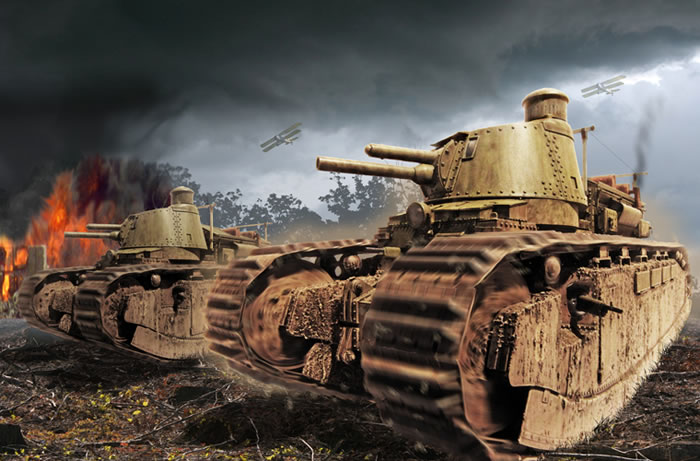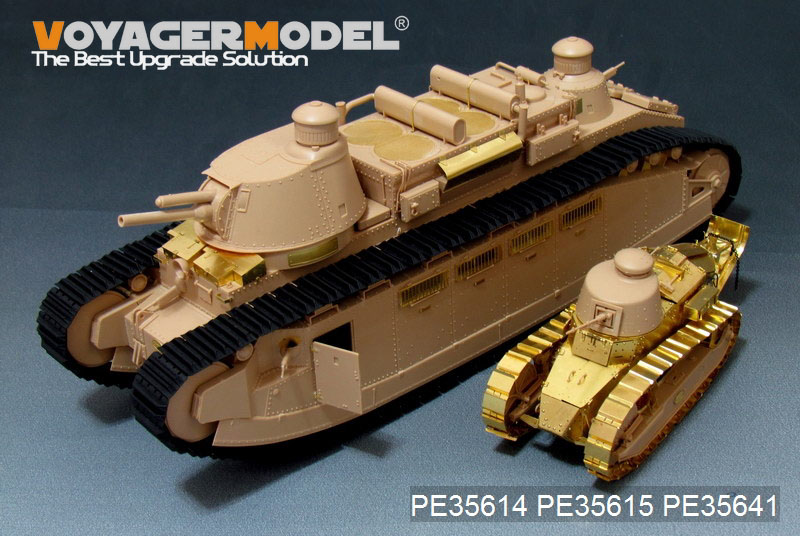Siitä oli tulossa maailman suurin panssarivaunu.
Panssarivaunun suunnittelu alkoi sodan viimeisenä vuonna, ja aselepo solmittiin ennen kuin Char 2C:tä oli ehditty käyttää kertaakaan.
Sitä käytettiin kuitenkin lyhyesti Ranskan puolustuksessa kaksikymmentä vuotta myöhemmin.
Vaunuja valmistettiin vain kymmenen kappaletta vuosien 1919-1921 välisenä aikana.
Char 2C oli kolme metriä leveä, noin neljä metriä korkea ja yli kymmenen metriä pitkä. Panssari oli paksuimmillaan jopa 45 mm, mikä nosti vaunun painon 69 tonniin.
Char 2C:n miehistöön kuului 12 jäsentä. Aseistuksena oli 75 mm tykki ja neljä 8 mm konekivääriä.
Char 2C AlsaceType: Super-heavy tank
Place of origin: France
In service: 1921–1940
Used by: France
Wars: World War II
Designed: 1917
Produced: 1921
Number built: 10
Variants: Char 2C bis
Weight: 69 tonnes (68 long tons; 76 short tons)
Place of origin: France
In service: 1921–1940
Used by: France
Wars: World War II
Designed: 1917
Produced: 1921
Number built: 10
Variants: Char 2C bis
Weight: 69 tonnes (68 long tons; 76 short tons)
Length: 10.27 m (33 ft 8 in)
Width: 3 m (9 ft 10 in)
Height: 4.09 m (13 ft 5 in)
Crew: 12
Armour: 45 mm (1.8 in) max.
Armament: 75 mm gun four 8 mm machine guns
(three in gimbal ball mounts at front and both sides forward, one mounted in a rear turret)
Engine:Two 6-sylinder casoline Daimler/ Mercedes 250 hp
Range:150 km (93 mi)
Speed:15 km/h (9.3 mph)
The Char 2C, also known as FCM 2C, is a French super-heavy tank developed, although never deployed, during World War I. It was, in physical dimensions, the largest operational tank ever made.
In December 1917 the first prototype, the FCM 1A, was ready to be shown to an investigating commission. Mourret had been replaced as head of the commission by Estienne, whose good friend General Philippe Pétain, the new High Commander of the French Army, asked him to use his position to end the project. Estienne told Pétain that this was ill-advised while the public was questioning why these heavy tanks had not been produced.
Besides, the allies (specifically the British and the US) would only consent to give France 700 of the new Mark VIII Liberty design if France had made at least a token effort to produce its own heavy tanks. Thus the French authorities had to delay the project while outwardly endorsing it. Estienne had already set this course by choosing the heaviest version, the "C", for production, requiring a completely new prototype, causing a considerable delay. Then Pétain demanded unreasonably high production numbers, thus delaying planning and initiating a political row.
Besides, the allies (specifically the British and the US) would only consent to give France 700 of the new Mark VIII Liberty design if France had made at least a token effort to produce its own heavy tanks. Thus the French authorities had to delay the project while outwardly endorsing it. Estienne had already set this course by choosing the heaviest version, the "C", for production, requiring a completely new prototype, causing a considerable delay. Then Pétain demanded unreasonably high production numbers, thus delaying planning and initiating a political row.

Pétain asked for 300 heavy tanks to be ready by March 1919, causing a quarrel to erupt between Clemenceau, who was both Prime-Minister and Minister of War, and Louis Loucheur, the Minister of Armament, who felt it was impossible to provide the labour and steel required. Meanwhile, Estienne and Pétain complicated the issue with further demands. Pétain asked for special pontoons, and Estienne demanded battering rams and electronic mine detectors to be fixed. When the war ended, not a single tank had been built.

At first, the production order for the Char 2C was cancelled. Despite the end of hostilities, however, strong political pressure to adopt new heavy tank projects remained, as there was now a considerable surplus capacity in the heavy industry. To stop this, the Direction de l’Artillerie d’Assaut on instigation of Estienne decided in April 1919 to procure ten Char 2Cs after all, and use this as an argument to reject any other projects.
This wasn't completely successful; as late as 1920 it was proposed to the Section Technique des Appareils de Combat to build a 600-ton tank with 250 mm armour.
At FCM Jammy and Savatier finished the Char 2C prototype, the other nine tanks being built almost simultaneously; all ten were delivered in 1921 and modified by the factory until 1923.
Super-heavy French tank (4)
Char 2C Super heavy French tank prototype (5)
They would be the last French tanks to be produced for the home market till the Char D1 pre-series of 1931.
This wasn't completely successful; as late as 1920 it was proposed to the Section Technique des Appareils de Combat to build a 600-ton tank with 250 mm armour.
At FCM Jammy and Savatier finished the Char 2C prototype, the other nine tanks being built almost simultaneously; all ten were delivered in 1921 and modified by the factory until 1923.
Super-heavy French tank (4)
Char 2C Super heavy French tank prototype (5)
They would be the last French tanks to be produced for the home market till the Char D1 pre-series of 1931.

Ei kommentteja:
Lähetä kommentti
Any explosive ammunition or empty cores, you can put in this.